Photographs: Still from Paa Sanaya Dalal
The traditional handwoven textile is well into its second coming and a newfound respect for it has developed within the Indian fashion fraternity.
From standing as a symbol of India's freedom struggle to being paraded on the runway at the country's many fashion weeks, the handspun fabric of khadi has certainly come a long way.
Moving away from its traditionally coarse, thick brown appearance, Indian designers of today have managed to breathe new life into khadi, using their imagination and new techniques of weaving to create a gamut of colours and light, breathable garments.
Despite their efforts, the fabric has never quite been associated with high fashion; high-end shoppers prefer to get more bang for their buck, spending on more obviously opulent ensembles that sing of extravagant price-tags. It's only big names like Sabyasachi Mukherjee, with his passion for Indian textiles, who have stayed faithful to ethnic cultural influences on fashion and enticed clients with khadi. Sabya has been famously quoted as saying in an interview that he finds it "strange that many Indian designers have nothing to do with local, hand-woven fabrics I genuinely love khadi. Its refinement lies in its humility, which is why I have used it in all my collections."
The designer put out an all-khadi bridal line last year, only to watch it fly off the shelves. Last month, he closed Dubai Fashion Week with an all-khadi collection modelled along Western lines. What's more, he has drawn Bollywood to the cause, dressing heroines like Vidya Balan (Paa) and Aishwarya (Ravana and Guzaarish) almost exclusively in khadi outfits on screen.
Fortunately, the next generation of couturiers like Rahul Mishra, Anand Kabra and Soumitra Mondal are following in Sabya's footsteps and the recently concluded fashion weeks in Mumbai and Delhi have witnessed handloom textiles on the catwalk like never before.
Slowly but surely, the Indian consumer is becoming more discerning towards eco-friendly, natural garments that do justice to our tropical climate. Leading the pack of organic fabrics is khadi. Several Indian fashionistas are hailing it as the Big Fat Indian Trend of 2010. We spoke to a few designers and they weigh in on khadi's transformation from crude to chic.
'I'm definitely pushing for it'
Image: A khadi ensemble showcased by Rahul Mishra at the WLIFWPhotographs: Courtesy PR Pundit
Among the many couturiers who recently showcased khadi at Lakme Fashion Week is Sashikant Naidu, a big fan of handloom textiles. Says the designer, "If you ask me, khadi is more than a trend; I presented an entire collection at the last Lakme Fashion Week created from khadi and I'm definitely pushing for it to become a trend. But how many people actually appreciate it?"
"Personally, I think it's a beautiful fabric and the good thing is that a lot of designers are talking about it, talking about collections in khadi. I'm more than happy to take it up," he adds. "What's more, it's easily available in a variety of colours today at retail outlets all over."
And that certainly holds true -- today, you can purchase khadi clothing off the rack at national chains like FabIndia, the Khadi & Village Industries Emporium in Mumbai, Khadi India in Delhi and the string of Khadi Gramodhyog Bhavan stores across a host of cities. And that's only skimming the surface -- bhandar stores across the length and breadth of the country will also give you what you want.
'Indian fabrics have always taken a backseat'
Image: Candice Pinto models a khadi waistcoat by Sabya worn over harem pantsPhotographs: Uttam Ghosh
"We are all so influenced by Western fabrics, silhouettes and falls," continues Naidu. "I don't know why, but comparatively, Indian fabrics have always taken a backseat. I love exploring our own garments and materials, and I don't understand why our designers are so taken by Western inspirations. When I applied for the LFW this year, I did so under the Indian category. Then they called me saying my creations had to be resortwear. With all the other designers conforming to this norm, I didn't want to be left out. So besides ethnic garments, I did put out resortwear, but using khadi. And people appreciated it."
When you see what's on offer on the Indian ramp, you're bound to agree with him. The Western outfits seem to outnumber ethnicwear. The Indian outfits you do see, most are in sleek, drapey synthetics, dripping crystals and going overboard with the embroidery.
"It's sad that foreign buyers are happier with the concept than our own buyers," rues Naidu. "Indian designers can do so much more with our own fashion influences and it will earn us much more respect on an international scale."
'We don't need blingy-clingy stuff!'
Image: At the recent LFW, Paromita Bannerjee's creations were lined with and tailored in khadiPhotographs: Uttam Ghosh
Designer Asmita Marwa disagrees with Naidu. She does not feel it is Western influence which is making Indian designers more appreciative of their own Indian influences. "Most Indian designers today are using Indian fabrics," she says. "And that makes perfect sense -- it works best in our weather and looks great on our type of silhouette. We don't need blingy-clingy stuff!"
"There are so many ways in which you can glam up khadi. When I used it in a recent line, I added on calligraphy, embellished it with flowers, used antique Benares work and basically dressed it up. You can create a lot, you just need an imagination to work with a fabric as basic and simple as this."
"Recently, I approached weavers to create a tartan checkered cotton khadi fabric for my collection," continues Marwa. "For specialised, lighter weaves with specific thread counts, you can have it custom made. For regular dyed khadi, I go to bhandar stores."
"Another good thing is that weavers are no longer exploited -- they are becoming aware of the value of their work in the commercial markets. Today, a host of NGOs like Dastkar are retailing khadi across India and acting as the middleman to protect their interests. Only in a very few remote pockets of the country are the artisans still unaware of how to price their goods."
'It's suddenly become very 'cool''
Image: Sahil Shroff poses on the ramp in a handspun Aneeth Arora ensemblePhotographs: Sanjay Sawant
Marwa is also of the belief that 2010 is a big year for khadi. "I definitely see a shift towards natural fabrics this year," she says. "Not only khadi; muls, muslins and linens too. Broadly speaking, I've hardly ever used synthetics -- all my creations are mainly cotton."
Speaking about khadi specifically, the designer says, "It has suddenly become very 'cool'. The Indian consumer is slowly becoming aware of and appreciating the fact that natural fabrics are not only practical, but they're fashionable too. Even abroad, everyone is gearing up towards being eco-friendly."
And it's about time, too! Instead of watching folks sweat it out at cocktail and sangeet parties in caked-on makeup and silky outfits that cling to the body, why not go the fresh and organic route?
'I would say it is still an emerging trend'
Image: Nicole Faria in a khadi sari by Sashikant NaiduPhotographs: Sanjay Sawant
Designer Vijay Balhara believes that khadi, while an emerging trend in the Indian market, is still in a very nascent stage. "I haven't used khadi in my most recent collection, I have used cotton. And for fall/winter, I'll be using silks, brocades and georgettes. But I do believe that it is a wonderfully comfortable fabric -- that's part of its appeal -- and I'm sure with subtle detailing, wonders can be worked upon it," he enthuses.
Balhara certainly has a point. Aside from the Sabyas and Kabras, a relatively lesser-known designer can hardly expect to meet with success at this point in time if s/he puts a heavily khadi-oriented collection on the racks. You can expect most to wade into the pool with an abundance of caution.
'Packaging is everything'
Image: A trademark handspun Sabya creationPhotographs: Uttam Ghosh
Since the Indian customer is slowly opening up to the idea of 'less is more', however, it does make things easier for designers looking to make a foray into Indian fabrics and eco-friendly clothing.
When it comes to translating the change in attitude towards khadi into financial gains, Naidu is very forthcoming. "The days are gone when a product used to speak for itself," he says. "Today, you need to package your product well, get PR agents on board, ensure your marketing is effective -- only then will you find that it does well for itself!"
'Indian designers are talented enough to incorporate khadi and the latest trends'
Image: Asmita Marwa had this checkered tartan khadi fabric specially createdPhotographs: Dominic Xavier
How far can you take things when it comes to incorporating khadi into today's trends like jumpsuits, tunics and the like?
Naidu is confident of the Indian fashion industry's ability to pull it off. "I'm sure Indian designers are talented and creative enough to incorporate khadi into the latest trends. We always design keeping in mind silhouettes and fabric -- there's really no reason why jumpsuits and the like can't be incorporated into today's garments within reason."
To be sure, recent fashion shows have seen some cutting-edge designs incorporating handloom textiles, like Paromita Banerjee's 'The laal paar and other stories' collection showcased at the last LFW and Aneeth Arora's 'pero' from the previous installment.
'It's a thick fabric, a little difficult to work with'
Image: This pretty khadi summer dress is the handiwork of Soumitra MondalPhotographs: Rajesh Karkera
Marwa is also of the opinion that khadi can play a significant role when it comes to today's trends, but a limited one.
"It's a thick fabric, a little difficult to work with," she explains. "It's okay for jackets and coats, but not for jumpsuits or anything that requires drapes -- for those, cotton works better. You do, however, get khadi in different weaves; these are lighter fabrics and if you have it specially spun keeping in mind a specific garment, then you can definitely use it to style jumpsuits, sharara pants and palazzo pants."
Rather than take the shortcut and choose readymade synthetic textiles, however, couturiers are going the extra mile and getting khadi woven with thread counts as high as 100-120 per square inch, as opposed to the coarser 60 per square inch.
'Synthetics are sheer blasphemy!'
Image: An outfit from Kolkata-based designer Bibi Russell, known for her dedication to handloom textilesPhotographs: Avishek Mitra
"With so much exposure to print and the media, the Indian consumer is becoming very aware," Marwa continues. "They don't mind spending. They don't want Bangkok synthetics anymore, those are just plain tacky. Five years ago, they were hip and cool, but today they're sheer blasphemy!" (laughs). "I believe that synthetics are just not cool anymore."
That's a style tip right there -- ditch those tightie-wightie lycras and spandex in favour of cooler linens, cottons and the like!
'Indian consumers have not been associating khadi with high-end fashion'
Image: One of Anuj Sharma's khadi creationsPhotographs: Sanjay Sawant
"Up until now, Indian consumers, particularly women, have not been associating khadi with glamour or high-end fashion," muses Balhara. "It's been highly underestimated and the comfort factor has been completely ignored. Glamour and style have to be added on and it is only now that it is slowly emerging as a trend. They (the consumers) will get used to it gradually, when comfort takes centre stage. When luxury is not a priority, khadi will shine."
"Even fashion designers are artists," he adds. "Fashion is a medium to send across the right message about nature and our surroundings, to awaken awareness in people. It gives that missing edge to natural fibres like khadi. General awareness of naturally woven fabrics is spreading through the Indian fashion fraternity. It's our own, after all and we know it best."


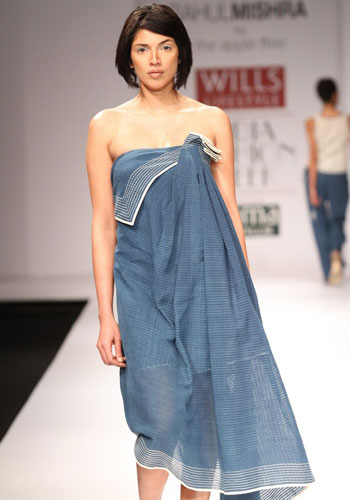
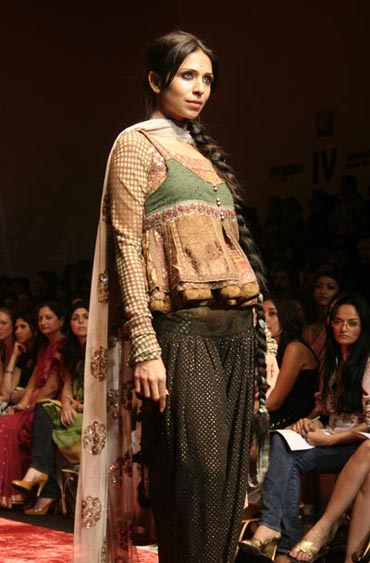
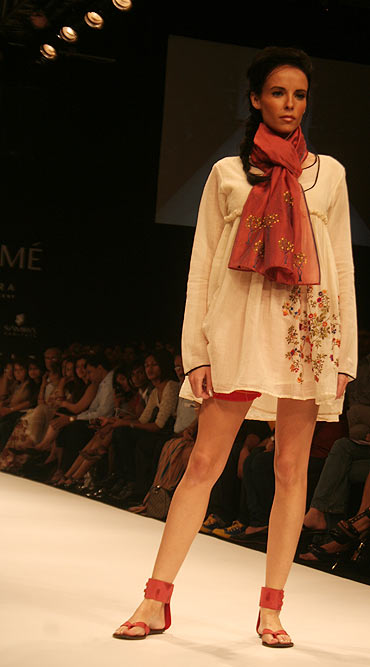

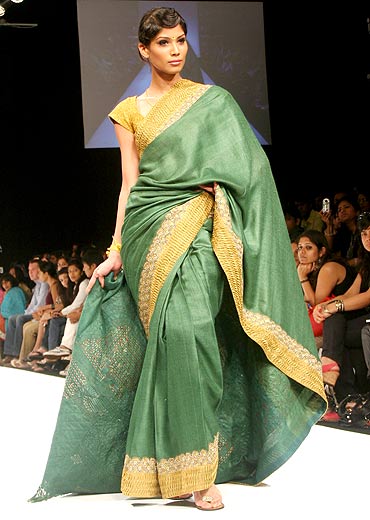
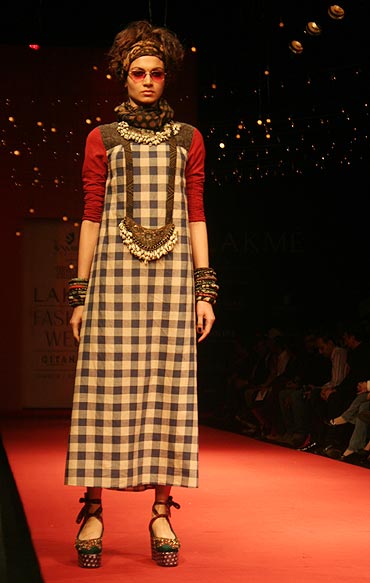
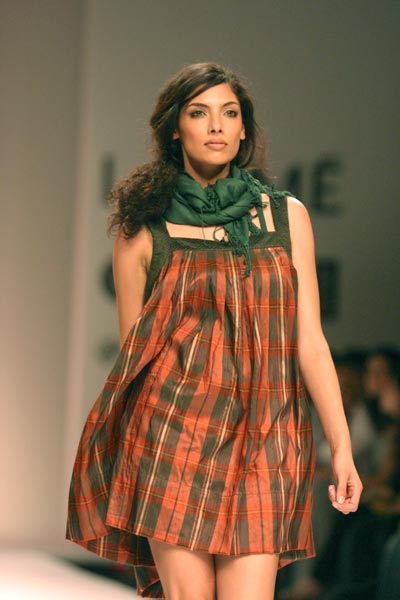
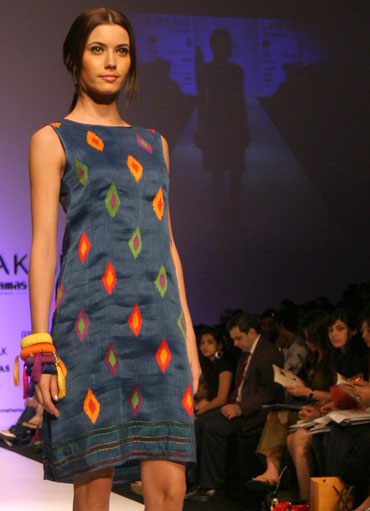
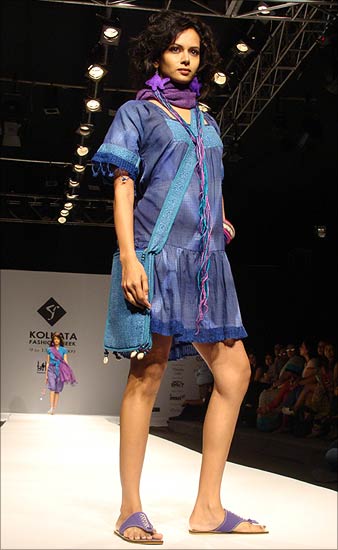
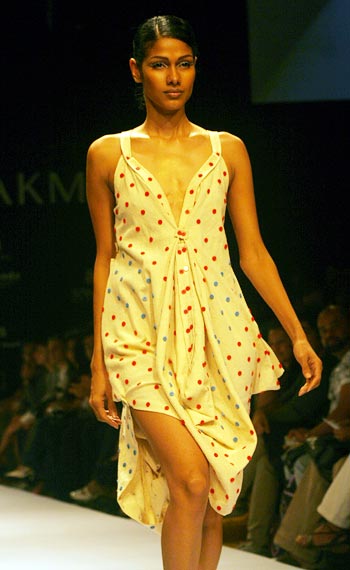
Comment
article